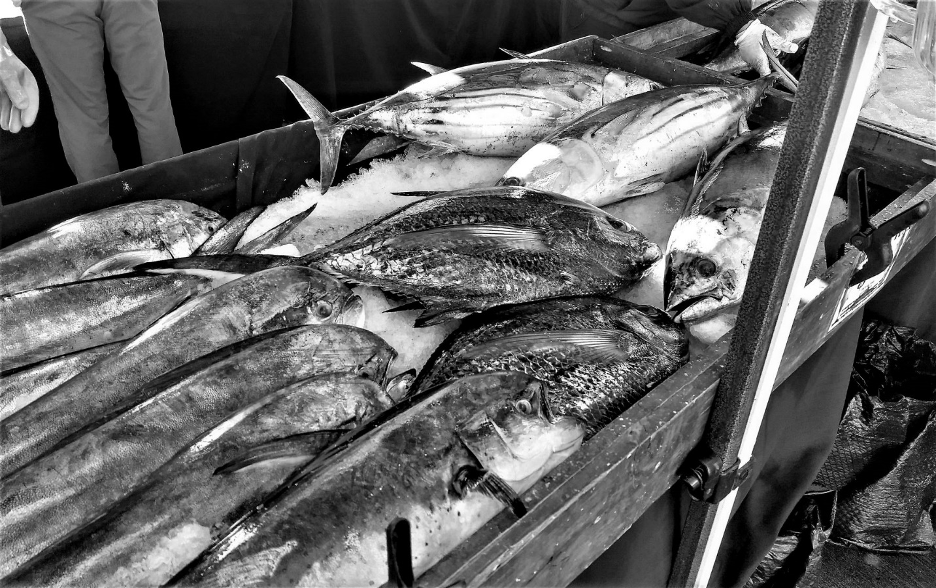
Sheikh: … It will be a miracle of God if it were to happen. Your expertise and my money are not alone enough, I know. But just as Moses found water in the wilderness, if God wills it, fish will swim in the Wadi Aleyn.
Fred: I’m more of a facts and figures man, I’m afraid.
Sheikh: You are not a religious man?
Fred: No. No, I’m not.
Sheikh: But you are a fisherman.
Fred: I don’t quite follow.
Sheikh: How many hours do you fish before you catch something. Dozens?
Fred: Gosh, hundreds, sometimes.
Sheikh: Is that not a bad use of your time? For a facts and figures man?...........But you persist in the wind and the rain and the cold with such poor odds of success. Why? Because you are a man of faith, Dr. Alfred. And in the end, you are rewarded for your faith and constancy. With a fish!
—Salmon Fishing in the Yemen, 2007
Saving faith for another time (literally), I pursue Dr. Alfred’s science, and my recent work involves reconciling facts, figures and fish (markets). By understanding participants’ behavior and the relevant public efforts, the larger goal of this research is to optimize market design that best facilitates the trade and consumption of sustainable species, and support fishing communities that are most vulnerable to climate change. Fish markets are also one of the most unassuming representations of a society/region. Very rarely do fish markets (wholesale) attract those outside of the business; hence through the unadulterated market enthusiasm it is possible to get a glimpse of the culture and the people they epitomize. I am interested in both the economics and sociology of fish markets, and their crossroads.
My research exploits the incredible variety in designs that fish markets are characterized by: fixed price/label, like the Tuna Harbor Dockside Market in San Diego, California; bilateral bargaining, as seen in many developing countries including Karachi fisheries; English auctions (ascending bid), like the famous Tsukiji fish market in Tokyo; Dutch auctions (descending bids), as seen in Scotland’s Shetland market. Some markets are formally organized, while many remain decentralized; there are also the regional variations of these standard mechanisms in various local markets. This heterogeneity in the controlled environments and the uniqueness of labor associated with the respective markets, when paired with short term weather volatilities and long-term climate change patterns allow for multi-faceted analysis of fish markets.
Having studied the Shetland fish auctions in Scotland in detail, I am able to observe the effect of consumer preferences and facility upgrades on market outcomes. Like most produce markets, the shopping ‘traffic’ is lowest on Tuesday and Wednesdays in Shetland fish market, and is highest on Mondays and Fridays. One of my findings suggest that buyers of whiting fish in Scotland are much more sensitive to price than whiting buyers in NY’s Fulton fish market. Since whiting is ranked as a sustainable fish by Scottish Fisheries, public policies aimed at improving the attractiveness of whiting (as opposed to its current reputation as a low-grade specie) and affordability would encourage more sustainable consumption.
Shetland fish market is also a great epitome of centralized Dutch auctions, including online auctions, and I have used this opportunity to evaluate the impact of a technological development funding on this market. As a result of this technological upgrade buyers now have advance access to the electronic sales catalogue for each day’s landing at Shetland, and the quality of operations and traceability of catch has greatly improved. Unsurprisingly, the volume of sales has increased a lot since. Using information from all species transactions, I find that consumers’ sensitivity to prices has decreased overall after this technological ‘shock’. This reveals an interesting insight about these auctions: not only sales are improved as a result of technology facilitated but that consumers are also willing to pay a ‘premium’ for the ease of doing business. This lends to valuable recommendations for most of decentralized fish markets which could benefit from leveraging technology to improve experience for participants.
Using structural modeling, I have further disaggregated consumer preferences in Shetland fish auctions, and studied consumer substitution patterns in this market. The main results are telling: consumers value ‘size’ more that ‘type’. That is, a potential buyer of high-grade specie 1 would much rather resort to another high grade specie 2 as a substitute when high grade specie 1 gets more expensive, rather than choosing lower grade specie 1. Size is the primary measure of grade; these findings are fascinating, because warming of oceans is leading to decrease in overall size of fish, and a reversal of global warming could potentially increase the ‘value’ of fish.
Switching to the supply side, developing countries’ fish markets offer a fascinating divide in labor across ethnic, gender, and sectarian lines. While women’s participation is largely limited to low valued activities in the fishing supply chain, fishing communities have come to organize themselves distinctively, both socially and geographically. I am studying the impact of climate change, regulations, and ‘redevelopment’ of fish markets in South Asia, as they affect the diverse stakeholders in the fishing business and reshape buyer-seller relationships. I am interested in the evolution of the economic status of specialized groups in both the artisanal and the formal fishing sectors, with the aim of recommending market designs that lend resilience and sustainability.
